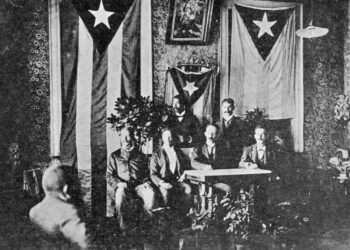With a vast record, which allows her to move from comedy to tragedy, and play elegant or vulgar women, and express misery, selfishness, dedication and lack of interest, Isabel Santos is considered one of the best Cuban cinema and TV actresses especially now that it just been premiered Vestido de Novia, by Marilyn Solaya, and La pared de las palabras is about to be released, in which she returns to Fernando Perez’s cinema after her stellar or controversial performances in Clandestinos (1988) and La vida es silbar (1998).
Isabel Santos, like the great Russian actor Vyacheslav Tikhonov, the one who starred in some classics of Soviet cinema and the series Diecisiete instantes de una primavera, believes that actors have wrinkles on the forehead and many wounds in the heart, by dint of tears required by their characters. Isabel was born actress, and in cinema or television she faced the cameras, and most of her characters, as if her life depended on it. She devoted herself first to television, where she became a kind of myth from her earliest roles on the series Pasos hacia la montaña and Algo más soñar. These different, tragic characters, all coming from a golden age of Cuban television, sealed the beginning of a career marked by great challenges and risk.
After graduating from the National School of Art (ENA by its Spanish acronym) in 1982, along with fellow students as Nestor and Luisa María Jiménez, Omar and Jorge Felix Ali, Lily Renteria, Jorge Martinez and Alberto Pujols, she received the first call from cinema through the role of the young Yolanda, along with Rosa Fornes, on one hand, and Mario Balmaseda, on the other, on the sitcom Se permuta, by Juan Carlos Tabio. Isabel represented, somehow, the whole Cuban youth, ranging between artifice and hypocrisy, or authenticity and openness, a polarity respectively embodied by the characters of Rosa Fornes and Mario Balmaseda, mother and future couple of Yolanda .
At this early stage of her career Isabel also played an important character in Lejanía (1985, by Jesús Díaz) because she was fortunate to represent, for the first time in Cuban fiction cinema, values and uprooting of Ana, a Cuban taken to exile without having any responsibility in the decision to live in another country. There is a m emorable scene on the roof where the girl recognizes herself (and I quote from memory) too from Havana to be a New Yorker, and too New Yorker to be from Havana.
The second stage of the career of this actress begins with her very natural and spontaneous interpretation of Nereida in Clandestinos, the role that won her the Best Female Performance Award in the Havana Film Festival , a prize to which similar recognitions were soon added at festivals in Rio de Janeiro and Cartagena. Accompanied by Luis Alberto García, Isabel Santos provided an unusual accuracy not only to the remembered final scene of the film (scene chosen by many fans as the best of Cuban cinema) but to the entire journey of the character, become again symbol of Cuban youth in a time of immense sacrifices for freedom and against dictatorship.
Fernando Perez has said in the interview entitled Fernando Pérez: “The cinema that I want”, by Mayli Estévez, “Clandestinos allowed me to peek, discover and feel the complexity of the job of an actor, things hitherto I never imagined. And it was a fortune, something I will always appreciate, being able to count in that film with Luis Alberto García and Isabel Santos, with whom I always want to work; but sometimes I can´t find the perfect role for them. I owe my discovery of the importance of acting to them. (…) That entire final sequence that public assimilated as one of the most moving, also was it for us. And success lies mainly on feelings, in the interpretive truthfulness that Luis Alberto and Isabel gave it for nine days of creative fire. ”
Before and after her encounter with Cuban cinema and the international recognition that Clandestinos meant, Isabel Santos became a key figure in series and soap operas that demonstrated the possibility of making television programs with artistic rigor and creativity such as La Botija (1990) where she shone through the character La Mascavidrio, or Pasion y Prejuicio (1993) where she for the first time played a typical soap opera evil character, then Entre mamparas (1996) with a character whose complexity exceeded the average television in that and at any time. At this point in the late eighties and early nineties she also starred at small sketches that made Cubans laugh with the humorous program Conflictos, in which the actress was constantly changing roles but often played an equally flirtatious secretary but also evil, in the Marilyn Monroe way, but Cuban.
In cinema Isabel never settled for playing the sympathetic or neurotic girl, and apparently imposes setting new standards with every new job. In Adorables mentiras (1991, by Gerardo Chijona) the actress wanted to try her luck in the farce and parody through the character of Sissy, a liar that has a picture of herself totally divorced from real life. Isabel plays, along with Luis Alberto García, the negative of the characters with whom they both were enshrined in Clandestinos because Adorables mentiras featured two accommodating hypocrites, a climber and dishonest actress and screenwriter .
The second stage in the career of Isabel Santos closes with a return to the themes of exile in international coproduction Cosas que dejé en La Habana (1997), filmed in Spain by Manuel Gutiérrez Aragón, which gave her the opportunity to perform with the much admired Daisy Granados and Broselianda Hernández. Immediately afterwards, the reunion happens with Fernando Perez, who inserted her into the dreamlike and philosophical world of La vida es silbar in a supporting role: that of a foreigner who arrives in Cuba mounted on a balloon and soon makes contact with Elpidio (Luis Alberto again) who is trying to reconnect with his mother, Cuba, who has decided to leave him. Perhaps this is one of the most demanding roles in the physical, on the outside, because the girl has her head entirely shaved, she has really to mount a balloon, and talks with an uncomfortable Anglo-Saxon or German accent.
In a recent interview with CubaDebate, Isabel Santos declared as one of her problems the fact that she does not like to rehearse, and even tries to explain why: “I do not like perhaps because back in the nineties we filmed in 35 mm. For example, Fernando Pérez in La vida es silbar said: Luisito and Isabel are going to make take one because the others are for the beginners. They are not worse or better than you, but need more time. (…) I think that cinema is magic and when I say: Action! Then everything comes out. It really bothers me the first take to be fucked off if something happens, because I know I’m giving everything at that time. The second shot already requires further preparation and also gives you the chance to make it different. ”
After La vida es silbar there is a brief film pause until the third great chapter in the career of this actress starts, a path marked out by her encounter with Humberto Solas in Miel para Oshun (2001) and Barrio Cuba (2005) representing the maximum effort of the actress to put on display the hardest: the common woman, supporting in both films the character of Jorge Perugorría in search of his mother throughout the country, or in efforts to sustain a couple through offspring. Isabel was Humberto´s muse in his two late movies. She had known his cinema, particularly Manuela, since she was a child, through ICAIC mobile cinema at the small town of Senado, in Noel Fernández sugar mill in Camagüey, where the future actress grew up .
In midst of the first decade of the century, she also appears in two co-productions: with Brazil, El Cayo de la muerte, and with Bolivia, Di buen día a papá, but the shooting in this country allowed her being inspired by the cult provided to Che Guevara by local people and shoots her first documentary (co-directed with her couple, photographer Rafael Solis): San Ernesto nacio en La Higuera (2006). At about this same time, the actress participated in several short films, in television series such as the singular Diana, and made minor characters such as a bolero singer in El Benny (2006) and herself in the tribute documentary Mujer que espera (2006) by Carlos Barba.
The real consecrating turning point in an actress without fear to risk or being seen in a negative role occurred between 2008 and 2010 with the aging writer who contributes to prostitute the young protagonist of Los dioses rotos (2008, by Ernesto Daranas) and Flora, the street sweeper in Casa Vieja (2010, by Lester Hamlet), a broken woman, eroded by a story of heartbreak and forgetting that the actress re-measured as if the absolute protagonist.
That human being, hurt and longing, homosexual transvestite with transsexual aspirations of Vestido de novia (2014, by Marilyn Solaya), and the mother attacked by the doubt about the futility of her sacrifice in La pared de las palabras (2014, by Fernando Pérez) give testimony of an actress in full maturity, suitable for mastering the vast expressive register, the wide dramatic tessitura that lets her move from comedy to tragedy, from elegant to the most common women, and fully express misery and selfishness, dedication and lack of interest.
The rigor , intelligence and instinct of Isabel Santos contributed to promote respect of a whole country for a generation of actors who debuted in the eighties, and who imposed on the Cuban audiovisual a mark of unquestionable quality. Although the actress, in the aforementioned interview, says with her characteristic bluntness that “I never mark anything, directors do it. The actor puts or removes, if allowed. In every movie I do I try to have that same speech of the director, you cannot forget about the script. I am part of a society, a generation with many dreams who wanted to change many things. I’m still having dreams, because if not, as one of her character says in Regreso a Itaca: “I take a rope and hang up myself.”
Of course Isabel Santos´ imprint in the Cuban audiovisual is indelible, and the fact that her generation managed to change things. Some of her contributions are listed above, and I even stopped in the classical Luz Marina de Aire frío (1999) or her latest documentary Viaje a un país que ya no existe. Isabel is a marvel of consistency and ductility on the screen, an actress capable of converting the astonishment and vehemence in her dearest companions.










